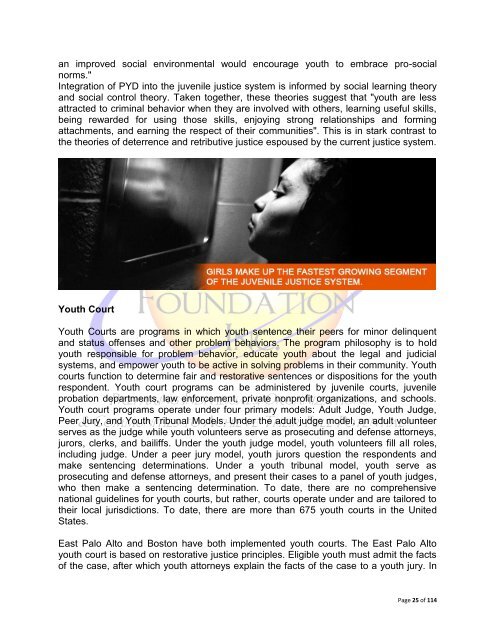African-American Youth in The Juvenile Justice System
African-American Youth in The Juvenile Justice System
African-American Youth in The Juvenile Justice System
You also want an ePaper? Increase the reach of your titles
YUMPU automatically turns print PDFs into web optimized ePapers that Google loves.
an improved social environmental would encourage youth to embrace pro-social<br />
norms."<br />
Integration of PYD <strong>in</strong>to the juvenile justice system is <strong>in</strong>formed by social learn<strong>in</strong>g theory<br />
and social control theory. Taken together, these theories suggest that "youth are less<br />
attracted to crim<strong>in</strong>al behavior when they are <strong>in</strong>volved with others, learn<strong>in</strong>g useful skills,<br />
be<strong>in</strong>g rewarded for us<strong>in</strong>g those skills, enjoy<strong>in</strong>g strong relationships and form<strong>in</strong>g<br />
attachments, and earn<strong>in</strong>g the respect of their communities". This is <strong>in</strong> stark contrast to<br />
the theories of deterrence and retributive justice espoused by the current justice system.<br />
<strong>Youth</strong> Court<br />
<strong>Youth</strong> Courts are programs <strong>in</strong> which youth sentence their peers for m<strong>in</strong>or del<strong>in</strong>quent<br />
and status offenses and other problem behaviors. <strong>The</strong> program philosophy is to hold<br />
youth responsible for problem behavior, educate youth about the legal and judicial<br />
systems, and empower youth to be active <strong>in</strong> solv<strong>in</strong>g problems <strong>in</strong> their community. <strong>Youth</strong><br />
courts function to determ<strong>in</strong>e fair and restorative sentences or dispositions for the youth<br />
respondent. <strong>Youth</strong> court programs can be adm<strong>in</strong>istered by juvenile courts, juvenile<br />
probation departments, law enforcement, private nonprofit organizations, and schools.<br />
<strong>Youth</strong> court programs operate under four primary models: Adult Judge, <strong>Youth</strong> Judge,<br />
Peer Jury, and <strong>Youth</strong> Tribunal Models. Under the adult judge model, an adult volunteer<br />
serves as the judge while youth volunteers serve as prosecut<strong>in</strong>g and defense attorneys,<br />
jurors, clerks, and bailiffs. Under the youth judge model, youth volunteers fill all roles,<br />
<strong>in</strong>clud<strong>in</strong>g judge. Under a peer jury model, youth jurors question the respondents and<br />
make sentenc<strong>in</strong>g determ<strong>in</strong>ations. Under a youth tribunal model, youth serve as<br />
prosecut<strong>in</strong>g and defense attorneys, and present their cases to a panel of youth judges,<br />
who then make a sentenc<strong>in</strong>g determ<strong>in</strong>ation. To date, there are no comprehensive<br />
national guidel<strong>in</strong>es for youth courts, but rather, courts operate under and are tailored to<br />
their local jurisdictions. To date, there are more than 675 youth courts <strong>in</strong> the United<br />
States.<br />
East Palo Alto and Boston have both implemented youth courts. <strong>The</strong> East Palo Alto<br />
youth court is based on restorative justice pr<strong>in</strong>ciples. Eligible youth must admit the facts<br />
of the case, after which youth attorneys expla<strong>in</strong> the facts of the case to a youth jury. In<br />
Page 25 of 114

















